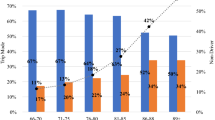Abstract
This paper investigates the role that acculturation, income, and education play in safety belt nonuse among Californian drivers involved in fatal Motor Vehicle Crashes (MVCs). To achieve this goal, measures of acculturation, income, and education were stochastically incorporated into the Fatality Analysis Reporting System (FARS). Using the 1990 California Tobacco Survey and U.S. Census data, we estimated the combination of zip-code-based measures that most accurately predicts an individual, language-based acculturation index for Hispanics and Asians. Logistic regression was used to investigate the role of these variables in safety belt nonuse in fatal MVCs. We found that acculturation has a positive direct effect on safety belt use among Hispanics. We hypothesize that this positive direct effect is caused by Hispanic immigrants learning the benefits of wearing safety belts. However, our study also suggests an indirect negative effect of acculturation on safety belt use through drinking and driving. Prevention programs aimed at increasing the safety of Hispanic drivers not only need to take acculturation differences into account, but also need to be comprehensive in their message, simultaneously targeting both seat belt nonuse and drinking-and-driving problems.
Similar content being viewed by others
References
Caetano, R., & Mora, M. E. (1988). Acculturation and drinking among people of Mexican descent in Mexico and the United States. Journal of Studies on Alcohol, 49(5), 462–471.
California Highway Patrol. (1998). Safety belt use soars—tops 90 percent. Perspectives 1998. Government of California. Retrieved, 2003, from the World Wide Web: http://www.chp.ca.gov/pdf/per98-22.pdf.
Davis, J. W., Bennink, L., Kaups, K. L., & Parks, S. N. (2002). Motor vehicle restraints: Primary versus secondary enforcement and ethnicity. Journal of Trauma, 52(2), 225–228.
Glassbrenner, D. (2003, March). Safety belt use in 2002—Demographic characteristics (Research Note DOT HS 809 557). Washington, DC: National Highway Traffic Safety Administration, National Center for Statistics and Analysis.
Haaga, J. (1986). Children’s seatbelt usage: Evidence from the National Health Interview Survey. American Journal of Public Health, 76(12), 1425–1427.
Harper, J. S., Marine, W. M., Garret, C. J., Lezotte, D., & Lowenstein, S. R. (2000). Motor vehicle crash fatalities: A comparison of Hispanic and Non-Hispanic motorists in Colorado. Annals of Emergency Medicine, 36(6), 589–596.
Hazuda, H. P., Stern, M. P., & Haffner, S. M. (1988). Acculturation and assimilation among Mexican Americans: Scales and population-based data. Social Science Quarterly, 69, 687–706.
Helsing, K. J., & Comstock, G. W. (1977). What kinds of people do not use seat belts?. American Journal of Public Health, 67(11), 1043–1050.
Klein, T. (1986, July). A method for estimating posterior BAC distributions for persons involved in fatal traffic accidents (DOT HS 807 094). Washington, DC: National Highway Traffic Safety Administration.
Lee, P., Orsay, E., Lumpkin, J., Ramakrishman, V., & Callahan, E. (1996). Analysis of Hispanic motor vehicle trauma victims in Illinois, 1991–1992. Academic Emergency Medicine, 3(3), 221–227.
Lerner, E. B., Jehle, D. V., Billittier, A. J., Moscati, R. M., Connery, C. M., & Stiller, G. (2001). The influence of demographic factors on seatbelt use by adults injured in motor vehicle crashes. Accident Analysis and Prevention, 33(5), 659–662.
National Highway Traffic Safety Administration. (2000). 1998 Motor Vehicle Occupant Safety Survey: Vol. 2. Seat Belt Report. DOT F 1700.7 (8–72). March 2000. Retrieved from http://www.nhtsa.dot.gov/people/injury/research/SafetySurvey/index.html
National Highway Traffic Safety Administration. (2001). NHTSA launches campaign to promote seat belt use among Hispanics. Department of Transportation’s Newsletter, NHTSA 26-01, available online at www.dot.gov/affairs/nhtsa2601.htm
Parada, M. A., Cohn, L. D., Gonzalez, E., Byrd, T., & Cortes, M. (2001). The validity of self-reported seatbelt use: Hispanic and non-Hispanic drivers in El Paso. Accident Analysis and Prevention, 33(1), 139–143.
State of California. (2003, June). California Current Population Survey Report: March 2002 Data. Sacramento, CA: Department of Finance.
Stiles, M. C., & Grieshop, J. I. (1999). Impacts of culture on driver knowledge and safety device usage among Hispanic farm workers. Accident Analysis and Prevention, 31(3), 235–241.
Swets, J. A., Dawes, R. M., & Monahan, J. (2000). Psychological science can improve diagnostic decisions. Psychological Science in the Public Interest, I(1), 1–26.
Tong, V. (1996). Home language literacy and the acculturation of recent Chinese immigrant students. The Bilingual Research Journal, 20(3 & 4), 523–543.
Voas, R. B., Fisher, D. A., & Tippetts, A. S. (2002). Children in fatal crashes: Driver blood alcohol concentration and demographics of child passengers and their drivers. Addiction, 97(11), 1439–1448.
Yu, S. M., Huang, Z. J., Schwalberg, R. H., Overpeck, M. D., & Kogan, M. D. (2002). Association of language spoken at home with health and school issues among Asian American adolescents. Journal of School Health, 72(5), 192–198.
Author information
Authors and Affiliations
Corresponding author
Rights and permissions
About this article
Cite this article
Romano, E., Tippetts, S., Blackman, K. et al. Acculturation, Income, Education, Safety Belt Use, and Fatal Motor Vehicle Crashes in California. Prev Sci 6, 139–148 (2005). https://doi.org/10.1007/s11121-005-3412-5
Issue Date:
DOI: https://doi.org/10.1007/s11121-005-3412-5



